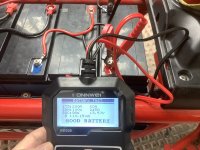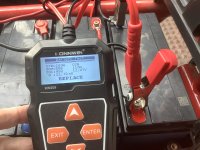BareKuda
100 W
- Joined
- Oct 25, 2021
- Messages
- 272
I recently purchased one of these cheap $20 battery testers to see if it can actually find the bad batteries in a 60v pack. While there is a maze of options to choose before running the test, it seems they are only used to modern the results of the same test process.
It seems these can do only a few basic measurements, and then apply math to estimate other data. It can measure voltage with high sample rate and measure the internal resistance of a battery. And with what can only be a tiny load on the battery for a few seconds, it measures voltage drop and estimates the max amp draw for about 30 seconds that would sag the battery down to its lowest allowed voltage.
SURFACE CHARGE
I look at surface charge as when you pumped in too many electrons and they aren’t absorbed but just hanging out at the battery terminal waiting to escape. They don't need to travel through the battery so internal resistance doesnt affect them much. This type of tester just measures them as if the battery has a very low internally resistance. So it will report higher than real CCA and lower than real internal resistance.
In a real load tester that puts the battery at a load of C/20 for 20 hours, or the old space heater coils that draw 300A, the surface charge cant throws off the results too much. But in these tiny digital testers which only work with a small amp of electron flow, it can make the results totally worthless.
FIRST TEST
My electric scooter uses 5x 12v20ah SLA batteries, and recently I noticed after only a short ride the voltage was sagging from what normally would be 62v-63v, down to 55v-58v. Then shortly thereafter the low voltage cutout started kicking in and out.
I already did a load test by putting the front tire against a wall and applying full throttle for a few seconds while measuring the batteries. You quickly see some dropping to 9v-10v while one was holding 11.5 which is pretty good.
So i charged up the battery and let it float for a whole day. Then i unplugged the charger and ran the motor for 10 seconds on high while on the center stand. Then i tested the batteries.

It shows 239 CCA and 10.38 mΩ which for this size and type of battery is as good as new.
Then i drove the scooter until i got voltage sag and came back and let it recover back to 65v pack voltage and measured again.

Now with essentially a negative surface charge, the batteries failed miserably. Nearly half the CCA and double the internal resistance.
The key point is if you want a fairly accurate reading you need to make sure the battery is at equilibrium. No surface charge and not recovering from a heavy load.
FINAL TEST RESULTS
After letting the batteries recover a bit while disconnected from any charger or load, i tested each battery and the ONLY battery it showed was good was the same one that held 11.5v during a real load test. This suggests that if used correctly and being aware of the affect if even the slightest surface charge, this can be used to detect a failing battery before it has time to kill the whole pack.
FINAL THOUGHTS
If you want to see if your 20AH battery will really deliver 1A for 20H, this is NOT the tool you need.
If you buy a new set of batteries you can use this tool for monthly test, as long as you follow the same procedure each time. After you choose the battery type you want and run a test, whatever CCA it gives you can then be used each time, since battery health is simple determined by the CCA you say it should have and the CCA it estimates you have.
By far the most important step will be getting your battery fully charged but no surface charge and not in recovery from a load. If its not fully charged and the readings are sketchy it will ask you to charge and retest, and then the surface charge is there again until you remove it.
Perhaps letting your batteries fully charge and enter float, then unplugging the charger and battery overnight would give repeatable results.
It seems these can do only a few basic measurements, and then apply math to estimate other data. It can measure voltage with high sample rate and measure the internal resistance of a battery. And with what can only be a tiny load on the battery for a few seconds, it measures voltage drop and estimates the max amp draw for about 30 seconds that would sag the battery down to its lowest allowed voltage.
SURFACE CHARGE
I look at surface charge as when you pumped in too many electrons and they aren’t absorbed but just hanging out at the battery terminal waiting to escape. They don't need to travel through the battery so internal resistance doesnt affect them much. This type of tester just measures them as if the battery has a very low internally resistance. So it will report higher than real CCA and lower than real internal resistance.
In a real load tester that puts the battery at a load of C/20 for 20 hours, or the old space heater coils that draw 300A, the surface charge cant throws off the results too much. But in these tiny digital testers which only work with a small amp of electron flow, it can make the results totally worthless.
FIRST TEST
My electric scooter uses 5x 12v20ah SLA batteries, and recently I noticed after only a short ride the voltage was sagging from what normally would be 62v-63v, down to 55v-58v. Then shortly thereafter the low voltage cutout started kicking in and out.
I already did a load test by putting the front tire against a wall and applying full throttle for a few seconds while measuring the batteries. You quickly see some dropping to 9v-10v while one was holding 11.5 which is pretty good.
So i charged up the battery and let it float for a whole day. Then i unplugged the charger and ran the motor for 10 seconds on high while on the center stand. Then i tested the batteries.

It shows 239 CCA and 10.38 mΩ which for this size and type of battery is as good as new.
Then i drove the scooter until i got voltage sag and came back and let it recover back to 65v pack voltage and measured again.

Now with essentially a negative surface charge, the batteries failed miserably. Nearly half the CCA and double the internal resistance.
The key point is if you want a fairly accurate reading you need to make sure the battery is at equilibrium. No surface charge and not recovering from a heavy load.
FINAL TEST RESULTS
After letting the batteries recover a bit while disconnected from any charger or load, i tested each battery and the ONLY battery it showed was good was the same one that held 11.5v during a real load test. This suggests that if used correctly and being aware of the affect if even the slightest surface charge, this can be used to detect a failing battery before it has time to kill the whole pack.
FINAL THOUGHTS
If you want to see if your 20AH battery will really deliver 1A for 20H, this is NOT the tool you need.
If you buy a new set of batteries you can use this tool for monthly test, as long as you follow the same procedure each time. After you choose the battery type you want and run a test, whatever CCA it gives you can then be used each time, since battery health is simple determined by the CCA you say it should have and the CCA it estimates you have.
By far the most important step will be getting your battery fully charged but no surface charge and not in recovery from a load. If its not fully charged and the readings are sketchy it will ask you to charge and retest, and then the surface charge is there again until you remove it.
Perhaps letting your batteries fully charge and enter float, then unplugging the charger and battery overnight would give repeatable results.

